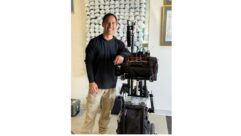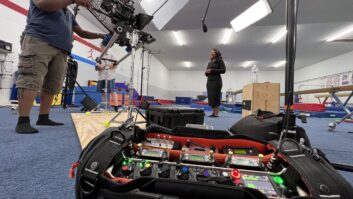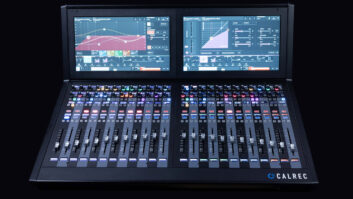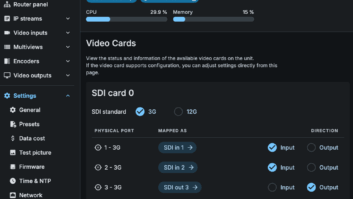BACK TO SCHOOL
May 1, 1999 12:00 PM,
Allan Collins
Over the past few years, education has grown from a once small market intothe primary source of business for many dealers, consultants and systemintegrators. This unparalleled transformation is the result of manyfactors, including the growth of several technologies, declining prices andchanges in how this sector is funded. In addition, educators are seeing thebenefit of incorporating computers and multiple media sources into theclassroom environment, and they need the help of the A-V industry to maketheir visions reality.
For those who may not have noticed this sector’s recent growth, know thatcolleges and universities have been making great strides in the use ofhigh-tech A-V equipment for communications and instructional purposes.Rapidly leaving us are the days when a student would wheel around aspaghetti-wired cart with a VCR and mid-sized television or even afilm-reel projector. Now, fixed data and graphics projectors withhigh-quality film screens are joining the omnipresent overhead models,along with computer-video interfacing, multiple media sources, centralizedcontrol systems and dedicated A-V staffs who keep it all running.
“I’ve been working with education for five years, and when I first started,people would ask why I worked with schools, believing there was no moneythere,” said Bryan Boehme, director of project engineering for HoffmanVideo. “In some cases they were right because at the time, schools were notwell funded for A-V technology. Now, with the publicity surrounding theInternet and other areas, funding for these technologies has been rapidlyincreasing as knowledge of their benefits grows.
What Boehme describes is the result of the most recent rise of educationalfunding as a political issue and the widespread desire by the sources offunding to see creative and innovative uses for it. With the incorporationof computers and A-V technology, educational facilities see a useful forumfor displaying their dedication to remaining on the cutting edge to theirprospective donors, students, parents and legislators. A-V technology is,of course, a means to an end. Although the various sources may be morewilling to allocate more funds for technology as opposed to other areas,the total amount of money coming in will always depend largely upon thenumber of students at each facility.
“It’s basically a business decision for colleges and universities thatcompete against each other for students and their money,” states DavidGales, senior associate at Ove Arup & Partners and the Arup Audio Visualconsulting group, for which educational facilities currently account for60% percent of business. “To remain competitive, educational facilitiesneed to deliver a product that appeals to their market, and their market isthe students who are technologically sophisticated.”
Boehme said, “What schools understand is that they have to draw students.That’s part of their revenue, and there are a lot more places to go thesedays, so the presence of technology becomes part of their advertising.Student interest in this type of education is high, and enrollments inschools that do these sorts of things go up.”
The fact that A-V technology will also add to the quality of education atthese schools is an added bonus. The attraction also applies toinstructors, particularly when a facility offers well-integratedvideoconferencing systems or distance learning.
“We are doing a job in Wyoming where the school has an instructor whospeaks five languages, yet there wasn’t a single language class they couldput together for German or Spanish because their weren’t enough students,”said Boehme. “They are now connected to 22 other campuses, however, and areable to put language classes together by drawing people in from thedistance-learning environment.”
The benefit to a school with such abilities is obvious. As Boehme continuesto explain, available instructors have always looked to forums where theymight focus on their primary discipline as much as possible. Schools thatare able to draw students from a larger body will benefit and attract morehigh-quality instructors as the technology gains greater presence andacceptance in the classroom. Whether the body of students is local orincludes cities miles away is essentially irrelevant.
The recent upswing in educational funding notwithstanding, incorporatingvideoconferencing into the classroom environment is often classified as afuture goal, should budgetary concerns arise. For the A-V professional,this means that systems may need to be initially designed for multiplesources with large-screen display, with the incorporation ofvideoconferenc-ing abilities at a later date. Cabling and such coretechnologies as switchers and other signal distribution equipment shouldreflect this and any other future goals. In some cases, cameras and scanconverters may be functional parts of the original installation butintended for use in videoconferencing once lines and codecs are furnished.
When asked about technology in the classroom, educators are quick to focuson the benefits it bestows upon the students. Charles Hickman, director ofprojects and services at the International Association of ManagementEducation said, “The employers who hire business-school graduates expectour students and graduates to enter the workplace with sophisticatedinformation technology skills. In terms of helping your graduates becompetitive, you had better have these technologies.”
The technologies Hickman refers to may include Internet, local and widearea network access at student desks, and videoconferencing. Othereducators see modern data projectors that draw from computers, VCRs, DVDplayers and other sources as valuable tools to incorporate into existingcurricula. The result is the need for such equipment as switchers, linemultipliers, scan converters and computer-video interfaces to go along withprojectors and computers.
Because this is a relatively new trend and many of the technologies beingdrawn from are new or under constant change, expect few in the realm ofeducation to be well-versed in their use. Typically, educators and those indecision-making roles for them have a good idea of what they want in termsof functionality, but they know little of what is necessary to reach theirgoals. For this reason, dealers, consultants, system designers andcontractors will need to spend a good amount of time with clients ineducation.
“Every client has a different reason for using these technologies, and weneed to understand those reasons before we can start designing systems forthem,” said Gales.
Training for both on-site A-V staff and faculty is also necessary, andcontractors may expect to see this need in the specs for such jobs.Instructors may not realize what resources are now available to them, andthey will need knowledgeable A-V professionals to get them on track.Although some schools may use technology as part of marketing ploys, onceinstructors understand how to make full use of the equipment provided, mostwill readily embrace it as a valued tool.
“First, we train the staff, both in how a room operates and what to do ifthings go wrong,” said Boehme. “Then, we go through and teach instructorshow everything works, with my point of view on how each room is supposed tobe used sprinkled in.”
“These technologies can really make teaching dynamic,” said Prashanth Nyer,a marketing professor at Chapman University. “We switch from text on thescreen, to videotapes, to pulling something off the Internet so quicklythat the presentation is absolutely seamless. I’ve already gotten to thepoint where I’ve started wondering how I ever taught without this.”
Central to keeping acclamation periods short in this or any otherinstallation is the incorporation of a user-friendly control system. Manyof the instructors who will use the equipment in their classes may haveVCRs or DVD players at home, but how to route either through a matrixswitcher and a line doubler to a projector is likely unbroken ground. Acustomized control system that might be optional in some jobs is really anecessity here. Large, easily understood controls on a touchscreen willgive the instructors, guests, teacher aids and the occasional substitutethe ability to command the equipment within the room without fumbling atthe rack every few minutes. These systems, when properly configured, willalso allow for a similar look and feel to the controls in each room, andthe average can move from one room to the next without relearning thecontrols.
Educational facilities, like other multi-room environments, will vary amonghaving local equipment in every room and a centralized media hub servingmany rooms or both. The argument against a media retrieval system for usewith a media hub is one of convenience to the faculty.
Gales said, “In some cases, the instructors develop their own media andbring it with them to the classroom, and they want to be able to produce itimmediately.”
In such cases, instructors typically are concerned about having to schedulemedia use ahead of time.
Boehme said, “Media retrieval systems work; it’s the system of people. Itis understandably difficult to know what you want to do a week in advanceand then to get it played back in your room at the right time. Mostinstructors want to be able to walk in with whatever media they want thatday.”
Where retrieval systems and media hubs do work is in DTV, RF and satellitereception. Reality with these systems is that having a point of entry tothe campus in every room is not practical. Scheduling a media retrievalsystem is the only efficient method of distributing these types of data toeach classroom.
Another key point to remember when working with education is that thesesites will be used by the same occupants for a longer time than many othertypes of sites.
“These guys own the buildings, and they need to get as much life out ofthem as they can possibly get, unlike corporate clients who move in forfive or 10 years and then they’re out of there,” said Gales.
This reality necessitates working with the architect of a new building asearly as possible to develop the infrastructure to support A-V systems overthe long term. This means designing accessible cable paths, adequate powerdistribution and resolving any lighting or acoustics issues that may ariseearly on. Educational facilities also have their own requirements under theAmericans with Disabilities Act and the state laws that need to be examinedbefore beginning. Remember, if all aspects are not considered, then you mayhave to return and redesign half the system sometime in the future. Designaccordingly.
In systems designed by Arup for long-term use, special care is taken toensure that the majority of components will maintain their usefulness viachanges in the system through either upgrades or flexibility of use.
“We look to products like those made by Extron Electronics to create a veryrobust core system,” said Gales. “We have what we call core and edgetechnologies. Extron’s products are core technologies in that they dealwith signal processing and distribution, and those technologies should beable to sustain several generations of what we call the edge technologies,which are the input and output devices.”
The result of the extra forethought in the educational arena will translateinto a sustainable site, as well as a satisfied customer. The benefit ofthe latter is something everyone in the industry can appreciate.










